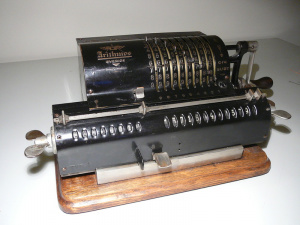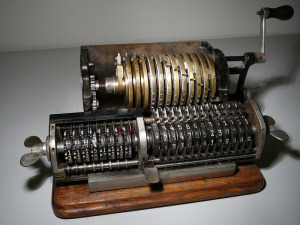Odhner
From Hackbox
Contents
Specification
- Original Odhner Arithmos Type 1 pinwheel calculator
- Serial 41603 (estimated from 1919-1922)
- 9 decimals input
- 13 decimals accumulator
- 8 decimals counter
Origin
Donated in 2013.
Condition
Working fine, but:
- a lot of the digits have lost their paint.
- there seems to be a piece missing next to the shift key, there are some holes.
Usage Hints
- Input is given by setting the 9 levers.
- The right hand register is the accumulator. It stores the result of the addition or subtraction.
- The left hand register is the counter. It counts the number of turns.
- Input is transferred to the accumulator by turning the crank, clockwise turn for addition, counter-clockwise for subtraction.
- The carriage can be shifted to align the input with a certain decimal of the accumulator and the counter.
- Both counter and accumulator have a reset handle, give it a full turn to set all digits to zero.
- The input can be easily reset by pulling the reset handle left while turning the crank until it pushes all levers to zero.
- (other than the above) always turn the crank a full turn. You can always undo a turn by turning in the opposite direction.
- A bell signals an overflow condition.
Addition
- Reset accumulator
- Input the first operand.
- Turn clockwise.
- Input the second operand.
- Turn clockwise.
- Read result from accumulator.
Subtraction
- Reset accumulator
- Input the first operand.
- Turn clockwise.
- Input the second operand.
- Turn counter-clockwise.
- Read result from accumulator.
Multiplication
- Reset accumulator and counter.
- Shift carriage all the way to the left.
- Input the first factor.
- Turn clockwise as many times until the last decimal in the counter equals the last digit of the second factor.
- Shift the carriage 1 position to the right.
- Turn clockwise as many times until the fore-last decimal in the counter equals the fore-last digit of the second factor.
- Repeat the last two steps for all digits of the second factor.
- Read the product from the accumulator.
Division
- Reset accumulator
- Shift carriage to the right, allowing space for decimals.
- Input the dividend.
- Turn clockwise to transfer it to the accumulator.
- Reset the counter.
- Input the divisor.
- Shift carriage to align the leading digits of input and accumulator.
- Keep turning counter-clockwise until the bell rings.
- Turn clockwise to undo the last turn.
- If accumulator contains all zeros, read exact quotient from counter, else shift carriage one position left and repeat last two steps.
- If not dividable, the process stops when the carriage is all the way to the left. Read approximate quotient from the counter and remainder from the accumulator.
Square root
- Reset accumulator
- Shift carriage all the way to the right.
- Input number
- Turn clockwise to transfer it to the accumulator
- Reset counter
- Shift carriage aligning left-most digit of input with left-most digit of the value in the accumulator
- Set a 1 in the input that is aligned with the right-most digit of the value in the accumulator and turn counter-clockwise
- Set the next odd number (3) and turn counter-clockwise
- Repeat with next odd numbers (5, 7, 9, 11, 13, ...) until the bell rings.
- Undo last turn by turning clockwise.
- Subtract 1 from input
- set a 1 in the next input digit (one decimal to the right)
- shift carriage left.
- repeat the process of subtracting odd numbers until the bell rings.
- If accumulator contains all zeros, read exact result from counter
- If carriage reaches left-most position, read approximate result from counter
See Also
http://www.rechenmaschinen-illustrated.com/pictures_odhner_swe.htm#Arithmos%20Type%201 http://home.comcast.net/~wtodhner/calcs.html

